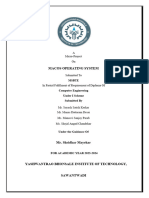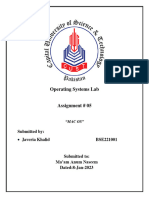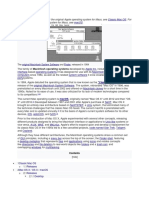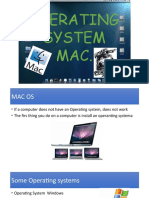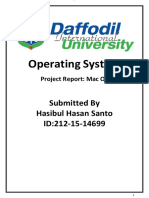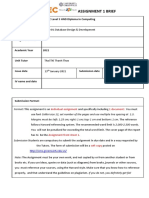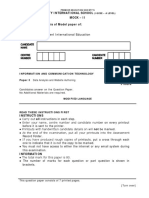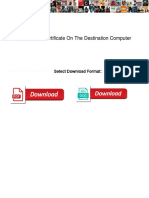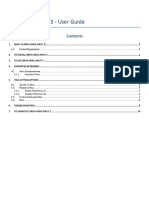A
PROJECT REPORT
On
“ INFORMATION OF MAC OPERATING SYSTEM”
Has been
Submitted in partial fulfillment of the Micro-project
In
“ Operating System”
By
1. Laxman Dinkar Kale 2208540160
2. Yash Dhananjay Gaikwad 2208540165
3. Virendra Dattatray Ware 23212130257
4. Sushant Dattatray Sakhare 23212130258
5. Ritesh Rajendra Lohor 23212130259
UNDER THE GUIDANCE OF
Prof. Dhobale.M.R
NBA Accredited & ISO 9001:2015 certified
VIDYA VIKAS PRATISHTHAN POLYTECHNIC
SOLAPUR
1
� NBA Accredited &ISO 9001:2015 certified
VIDYA VIKAS PRATISHTHAN POLYTECHNIC,
SOLAPUR
CERTIFICATE
This is to certify that the Micro-project entitled
“INFORMATION OF MAC OPERATING
SYSTEM”
Has been completed by
6. Laxman Dinkar Kale 2208540160
7. Yash Dhananjay Gaikwad 2208540165
8. Virendra Dattatray Ware 23212130257
9. Sushant Dattatray Sakhare 23212130258
10. Ritesh Rajendra Lohor 23212130259
Of
T.Y. (Computer Engineering)
Institute Code - 0854
Has been submitted in partial fulfillment of Micro-project in “Operating System ” per the
curriculum laid by M.S.B.T.E. Mumbai, during the academic year
2024-2025
Prof. Dhobale.M.R Prof. Dhobale.M.R.
(GUIDE) (H.O.D.)
2
� INDEX
Sr. No. Title Page No
1 Introduction 4
2 History Of macOS 5
3 Features and Functionality of macOS 6
4 Productivity and Efficiency 7
5 Security and Privacy 8
6 Mac OS versions 9
7 The advantages of Mac sOS 16
8 The disadvantages of Mac OS 16
9 Conclusion 17
3
�Introduction:
macOS (previously known as OS X) is the operating system developed by Apple
Inc. for its Mac line of personal computers and workstations. The abbreviation
"macOS" stands for "Macintosh Operating System”. It was first introduced in 2001
as the successor to the classic Mac OS. Since then, it has undergone many
updates and improvements to become the sophisticated and user-friendly
operating system it is today.
macOS is built on a Unix-based architecture and provides users with a stable,
reliable, and user-friendly experience. The operating system is designed to be
intuitive and easy to use, focusing on simplicity and elegance. The user interface
of macOS is clean, organized, and aesthetically pleasing, making it a pleasure to
use for both casual and professional users alike.
In addition to its sleek design and user-friendly interface, macOS is also known for
its stability and security. With its robust security features, the operating system
helps to protect users' data and privacy, making it a popular choice for individuals
and organizations.
4
�History Of macOS:
The history of macOS can be traced back to 2001 when Apple introduced the first
version of the operating system, known as Mac OS X 10.0 "Cheetah." This initial
release was a major departure from the classic Mac OS, as it was built on a Unix-
based architecture and offered improved stability and security. Over the years,
Apple has continued to refine and improve macOS, adding new features and
functionality while maintaining its signature simplicity and elegance.
In 2012, Apple released OS X 10.8 "Mountain Lion," marking the beginning of the
company's focus on integrating its other products and services. This trend
continued with the release of OS X 10.9 "Mavericks" in 2013, which introduced
new productivity features and improved performance.
In 2016, Apple renamed OS X to macOS and introduced macOS Sierra, adding
even more features and improvements, such as Siri integration and a new
universal clipboard that allows users to copy and paste between Macs and iOS
devices.
Today, macOS is a powerful and user-friendly operating system that continues to
evolve and improve. With each release, Apple adds new features and
functionality to help users be more productive, creative, and secure.
5
�Features and Functionality of macOS:
macOS is the operating system that powers the Apple Mac computer line. It offers
users a rich set of features and functionality that provides a seamless and intuitive
computing experience. This section will look closely at some key features and
functionality that make macOS a standout option for users.
Desktop:
Fig: Desktop Interface of macOS
Clean and uncluttered interface, with a focus on simplicity and ease of use
The Dock, located at the bottom of the screen, provides quick access to
frequently used applications and documents.
The Launchpad offers a grid-like interface for easily accessing and
organizing all installed applications.
6
�Productivity and Efficiency
Built-in apps for tasks such as email, web browsing, and productivity
Advance1d features like Continuity, which allows users to start a task on
one Apple device and continue on another
The ability to use multiple virtual desktops to organize and separate
workspaces
Integration with Apple Ecosystem:
Fig: Integration with Apple Ecosystem:
Integration with other Apple devices, such as iPhones and iPads, through
features such as AirDrop and Continuity.
7
� Access to the App Store, which offers a large collection of high-quality,
Mac-compatible apps.
Integration with Apple's cloud storage solution, iCloud, allowing users to
access and sync data across all their Apple devices.
8
�Security and Privacy
o Built-in security features, such as FileVault encryption, to protect users' data and privacy
o Regular software updates to address security vulnerabilities and improve the overall
stability of the operating system.
9
�MacOS versions
Over the years, Apple has released several versions of the operating system, each
offering new features and improvements. This section will look closely at some
key versions of macOS and their notable features.
macOS Monterey: The current version of Monterey was released in
October 2021. It comes with a refreshed design, new features for privacy
and security, and improvements to existing apps such as FaceTime, Safari,
and Photos. It also introduces a new Focus mode, which allows users to
control distractions and stay productive.
10
� Fig: macOS Monterey
macOS Catalina: Released in October 2019, macOS Catalina marked a
significant change for the operating system, as it was the first version to
drop support for 32-bit apps. This version also introduced features such as
Sidecar, which allows you to use an iPad as a secondary display for your
Mac, and Project Catalyst, which makes it easier for developers to port iPad
apps to the Mac.
Fig: macOS Catalina
11
� macOS Mojave: Released in September 2018, macOS Mojave was notable
for introducing a dark mode, which changes the appearance of the
operating system to a darker color scheme, making it easier on the eyes for
night-time use. This version also introduced new privacy features, such as
stronger protection for user data and enhanced tracking prevention.
Fig: macOS Mojave
12
� macOS High Sierra: Released in September 2017, macOS High Sierra
introduced several updates to the underlying technology of the operating
system, including updates to the file system and graphics technology. This
version also included improvements to the Photos app, such as new editing
tools and a new version of Safari that was faster and more efficient.
Fig: macOS High Sierra
13
� macOS Sierra: Sierra was released in September 2016, bringing several new
features and improvements to the MacOS platform. It introduced Siri to the
Mac and several new productivity features like Universal Clipboard,
allowing users to copy and paste between Macs and iOS devices. Sierra also
improved the Photos app, adding editing tools and organization options.
Fig: macOS Sierra
14
� OS X El Capitan: El Capitan was released in September 2015 and focused on
refining the performance and stability of MacOS. It introduced several
improvements to the built-in apps and system-level features, along with
performance optimizations and bug fixes. El Capitan also introduced Split
View, which allowed users to run two apps side by side, and improved
support for full-screen mode.
Fig: OS X El Capitan
OS X
Yosemite: Yosem
ite was released in October 2014 and marked a significant visual overhaul
of the MacOS platform. It introduced a new design aesthetic incorporating
a more modern and flatter look. It brought several new features and
improvements to the built-in apps and system-level features. Yosemite also
15
� introduced Continuity, which allowed users to switch between Macs and
iOS devices more seamlessly.
Fig: OS X Yosemite
The advantages of MacOS
Streamlined User Interface: Mac OS has an intuitive, easy interface yet still
offers all the functionality you need.
Hardware & Operating System Integration: Mac OS and the Apple hardware
it runs on are designed to work together seamlessly, resulting in a smooth
and consistent experience.
Security: Mac OS is less prone to security and malware issues than other
operating systems, providing peace of mind for users.
Integration with Apple Devices: Mac OS integrates well with other Apple
devices like iPhones and iPads, allowing for seamless data transfer and
tasks.
The disadvantages of Mac OS
High Cost: Mac products are generally more expensive than similar
Windows-based options, which can be a barrier for many users.
16
� Limited Software Availability: Mac OS supports fewer games and software
applications than Windows, which can be frustrating for some users.
Lack of Customization for Hardware: macOS offers little in the way of
hardware customization options, which can be a drawback for those who
prefer a more personalized setup.
Incompatible File System: The macOS file system is not compatible with
Windows, making it difficult to transfer files between the two operating
systems.
Conclusion:
The Mac operating system project successfully achieved its goals by delivering a
user-friendly, secure, and efficient computing experience. It introduced innovative
features like enhanced privacy controls, seamless integration with Apple
ecosystem, and improved performance. User feedback was integrated to refine
the interface and functionality, resulting in a robust and visually appealing OS.
Compatibility with a wide range of Mac hardware was ensured, offering users a
seamless transition. Extensive testing and bug fixes contributed to a stable and
reliable system. Overall, the project represents a significant advancement in the
Mac OS ecosystem, enhancing user satisfaction and productivity.
17


